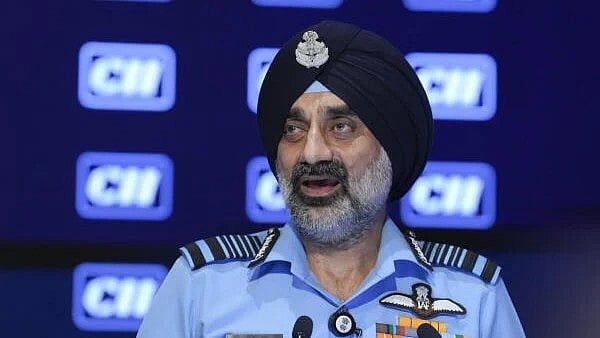
IAF Chief, Air Chief Marshal A P Singh.
Credit: PTI Photo
New Delhi: Indian Air Force (IAF) neutralised 11-12 Pakistan aircraft including F-16 and JF-17 fighter jets during Operation Sindoor, Chief of the Air Staff Air Chief Marshal A P Singh said on Friday, while dismissing Islamabad’s claim of shooting down seven Indian aircraft as “manohar kahaniya” (fanciful tales).
In his first media interaction post the Indo-Pak conflict in May, Air Chief Marshal Singh said the IAF raids destroyed four enemy radar sites, two command and control centres, two runways, three hangers, a large C-130J class aircraft and 4-5 fighter aircraft on ground.
Moreover, one large aircraft which could either be an airborne early warning and control aircraft or a signal intelligence aircraft, and five Pakistani flying fighter jets were downed, he said addressing the media ahead of the 93rd Air Force Day. One surface to air missile system was also destroyed.
Air Chief Marshal Singh, while delivering a talk in Bengaluru in August, revealed killing six Pakistani aircraft during Op Sindoor. The disclosure, however, didn’t include the aircraft on the ground as he spoke about only those enemy jets that were in the air during the conflict.
The IAF chief refused to speak about the Indian loss. “Why should I talk about it? Let them (Pakistan) talk about shooting down 15 of our aircraft and cater for 15 less in our inventory next time. I won't say anything about what happened, how much damage was done, how it happened. Let them find out,” he said.
“Have you seen a single picture where something fell on any of our airbases, something hit us, a hangar was destroyed, or anything like that? We showed so many pictures of their places. However, they couldn't show us even a single picture. So their narrative is 'Manohar Kahaniyan'. Let them be happy, after all, they also have to show something to their audience to save their reputation. That doesn't matter to me."
In response to the April 22 Pahalgam attack, India launched Operation Sindoor on May 7, targeting terror infrastructure in territories controlled by Pakistan. The strikes triggered four days of intense clashes that ended on May 10 with both sides agreeing to maintain a ceasefire.
On futuristic home-grown fighters, the IAF chief said the fifth generation advanced medium combat aircraft was scheduled to fly by 2028 and supposed to be inducted by 2035.
“Its a tough task but its possible. The AMCA technology is fairly clear in our mind as to what we want and what is required. We should be able to meet the timeline.”
Asked about the proposed LCA Mk-2 aircraft, Air Chief Marshal Singh said it would be in the same class as Tejas LCA Mk-1A but with more weapons, bigger weapons and higher endurance. The second lot of LCA Mk-1A can be converted into LCA Mk-2, but a call would be taken later.
On the much-awaited delivery of fully weaponised Tejas LCA-Mk1A, he said the good news was that the engine flow had started, but some more tests were to be done. “As soon as they certify the aircraft, we are ready. Hungry mouths are ready waiting for the food.”
The Tejas LCA Mk-1A manufacturer Hindustan Aeronautics Limited, Bengaluru blamed US major General Electric’s failure to supply the F-404 engines in time as the principal reason for the delay in delivering the home-grown combat jets to the IAF. The Indian firm has now received four engines and readied the first two aircraft which will be delivered after successful firing of the weapons.
